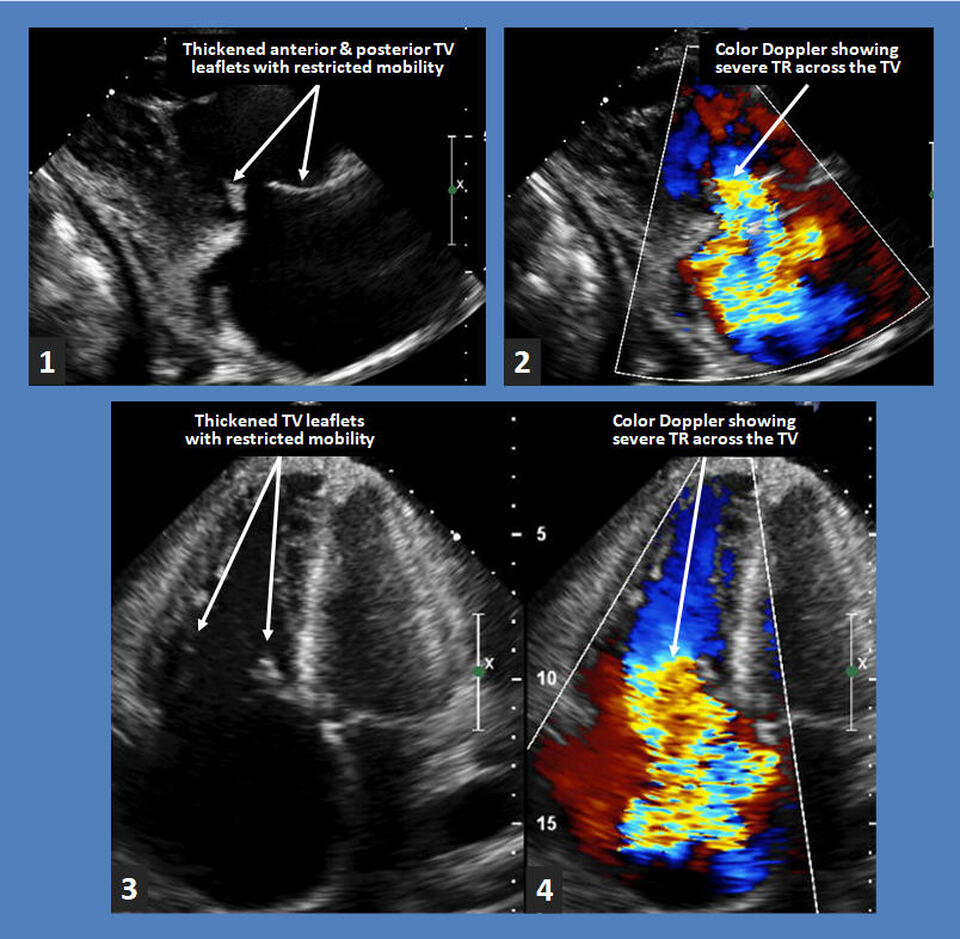March 2021 Issue
ISSN 2689-291X
ISSN 2689-291X
Cardiac Carcinoid..
A Tricuspid Valvulopathy!
Description
The figure above shows 2-D echocardiographic images associated with carcinoid heart disease. In Figure 1, modified parasternal long axis (PLAX) views of the right ventricular (RV) inflow across the tricuspid valve shows thickened and tethered anterior and posterior leaflets with restricted mobility. Figure 2 demonstrates severe tricuspid regurgitation (TR) by color flow Doppler across the tricuspid valve. Figures 3 and 4 reveal the same findings in the apical 4 chamber (4-C) views, in addition to significant dilatation of the right heart chambers due to RV failure caused by the long standing severe TR.
Discussion
Carcinoid tumors are neuroendocrine tumors derived primarily from enterochromaffin cells [1]. These tumors are rare with an incidence of 1.2 – 2.1 per 100,000 of the general population [2]. Although carcinoid tumors can be found anywhere in the body, they most commonly originate from the gut, particularly the terminal ileum and cecum. Carcinoid tumors secrete vasoactive substances that lead to certain paraneoplastic symptoms such as diarrhea, flushing, hypertension and bronchospasm. This vast array of symptoms is called Carcinoid syndrome. Carcinoid syndrome may also involve the heart and cause valvular disease, heart failure and metastatic tumor to the heart [3].
Carcinoid heart disease affects the right sided heart valves, most commonly the tricuspid valve, and to a lesser extent the pulmonic valve. The vasoactive substances which cause valvular damage are deactivated by the lungs before reaching the left side of the heart, thereby sparing the left-sided heart valves. Carcinoid valve disease is characterized by plaque-like deposition of fibrous tissue on the valve leaflets [4].
Early valvular disease associated with carcinoid is usually asymptomatic and is often diagnosed greater than a year and a half following the diagnosis of carcinoid syndrome. Valvular involvement is usually progressive in nature, ranging from mild disease, causing thickening and decreased mobility of leaflets with mild valvular regurgitation, to severely retracted leaflet with significant valvular regurgitation, as in the image above, and often valvular stenosis [5]. Tricuspid valve stenosis is less frequent than tricuspid regurgitation, but both often coexist. Tricuspid stenosis, however, is more common than pulmonic stenosis.
Symptoms of severe tricuspid valve regurgitation and/ or stenosis include lower extremity edema, ascites and pleural effusion which are usually seen with right sided heart failure.
Treatment of carcinoid heart disease involves a multidisciplinary approach and can be medical or surgical depending on the presentation [6].
Somatostatin analogues can improve symptoms in patients with carcinoid heart disease, but do not cause regression of established cardiac damage [7].
Surgical options include tricuspid and/ or pulmonic valve dilatation (for stenosis), resection or replacement. Percutaneous valve replacement in the pulmonary position and in the inferior vena cava (IVC) may offer an alternative for high surgical risk patients [8].
References:
- Gade AK, Olariu E, Douthit NT. Carcinoid Syndrome: A Review. Cureus. 2020 Mar 5;12(3):e7186.
- Modlin IM, Sandor A. An analysis of 8305 cases of carcinoid tumors. Cancer. 1997;79(4):813-29.
- Perry D, Hayek SS. Carcinoid Heart Disease: A Guide for Clinicians. Cardiology clinics. 2019;37(4):497-503.
- Jin C, Sharma AN, Thevakumar B, Majid M, Al Chalaby S, Takahashi N, et al. Carcinoid Heart Disease: Pathophysiology, Pathology, Clinical Manifestations, and Management. Cardiology. 2021;146(1):65-73.
- Bhattacharyya S, Toumpanakis C, Burke M, Taylor AM, Caplin ME, Davar J. Features of carcinoid heart disease identified by 2- and 3-dimensional echocardiography and cardiac MRI. Circulation Cardiovascular imaging. 2010;3(1):103-11.
- Ram P, Penalver JL, Lo KBU, Rangaswami J, Pressman GS. Carcinoid Heart Disease: Review of Current Knowledge. Tex Heart Inst J. 2019 Feb 1;46(1):21-27.
- Fox DJ, Khattar RS. Carcinoid heart disease: presentation, diagnosis, and management. Heart. 2004 Oct;90(10):1224-8.
- Yuan SM. Valvular Disorders in Carcinoid Heart Disease. Braz J Cardiovasc Surg. 2016 Sep-Oct;31(5):400-405.
Authors:
Hajira Malik, M.D.
Internal Medicine Resident
University of South Alabama
Mobile, AL
Maulikkumar Patel, M.D.
Cardiology Fellow
University of South Alabama
Mobile, AL
Nikky Bardia, M.D.
Cardiology Fellow
University of South Alabama
Mobile, AL
Bassam Omar, M.D., Ph.D.
Professor of Cardiology
University of South Alabama
Mobile, AL

